check engine YAMAHA JOG50R 2008 User Guide
[x] Cancel search | Manufacturer: YAMAHA, Model Year: 2008, Model line: JOG50R, Model: YAMAHA JOG50R 2008Pages: 72, PDF Size: 2.06 MB
Page 43 of 72
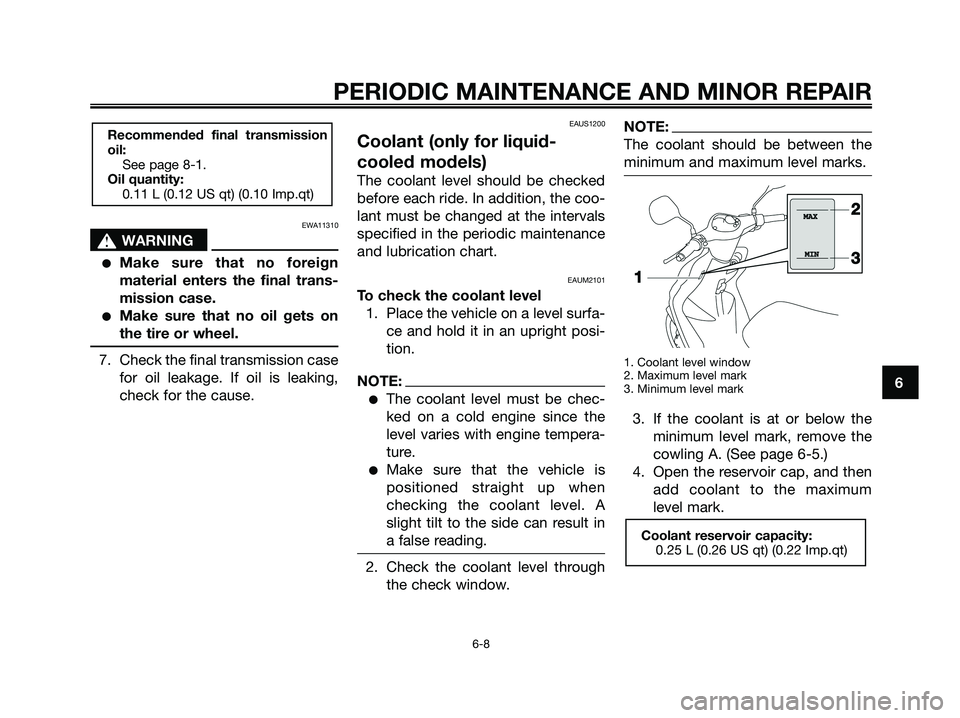
EWA11310
s s
WARNING
●Make sure that no foreign
material enters the final trans-
mission case.
●Make sure that no oil gets on
the tire or wheel.
7. Check the final transmission case
for oil leakage. If oil is leaking,
check for the cause.
EAUS1200
Coolant (only for liquid-
cooled models)
The coolant level should be checked
before each ride. In addition, the coo-
lant must be changed at the intervals
specified in the periodic maintenance
and lubrication chart.
EAUM2101
To check the coolant level
1. Place the vehicle on a level surfa-
ce and hold it in an upright posi-
tion.
NOTE:
●The coolant level must be chec-
ked on a cold engine since the
level varies with engine tempera-
ture.
●Make sure that the vehicle is
positioned straight up when
checking the coolant level. A
slight tilt to the side can result in
a false reading.
2. Check the coolant level through
the check window.
NOTE:
The coolant should be between the
minimum and maximum level marks.
1. Coolant level window
2. Maximum level mark
3. Minimum level mark
3. If the coolant is at or below the
minimum level mark, remove the
cowling A. (See page 6-5.)
4. Open the reservoir cap, and then
add coolant to the maximum
level mark.
Coolant reservoir capacity:
0.25 L (0.26 US qt) (0.22 Imp.qt)
Recommended final transmission
oil:
See page 8-1.
Oil quantity:
0.11 L (0.12 US qt) (0.10 Imp.qt)
PERIODIC MAINTENANCE AND MINOR REPAIR
6-8
6
5RW-F8199-E4.QXD 19/11/07 08:01 Página 43
Page 44 of 72

1. Coolant reservoir cap
2. Maximum level mark
3. Minimum level mark
ECA10471
CAUTION:
●If coolant is not available, use
distilled water or soft tap water
instead. Do not use hard water
or salt water since it is harmful
to the engine.
●If water has been used instead
of coolant, replace it with coo-
lant as soon as possible, other-
wise the cooling system will
not be protected against frost
and corrosion.
●If water has been added to the
coolant, have a Yamaha dealer
check the antifreeze content ofthe coolant as soon as possi-
ble, otherwise the effective-
ness of the coolant will be
reduced.
EWA10380
s s
WARNING
Never attempt to remove the radia-
tor cap when the engine is hot.
5. Close the reservoir cap, and then
install the cowling.
EAU33030
Changing the coolantEWA10380
s s
WARNING
Never attempt to remove the radia-
tor cap when the engine is hot.
The coolant must be changed at the
intervals specified in the periodic
maintenance and lubrication chart.
Have a Yamaha dealer change the
coolant.
EAU40370
Air filter element
The air filter element must be cleaned
and replaced at the intervals specified
in the periodic maintenance and lubri-
cation chart. Have a Yamaha dealer
clean and replace the air filter ele-
ment.
PERIODIC MAINTENANCE AND MINOR REPAIR
6-9
6
5RW-F8199-E4.QXD 19/11/07 08:01 Página 44
Page 45 of 72
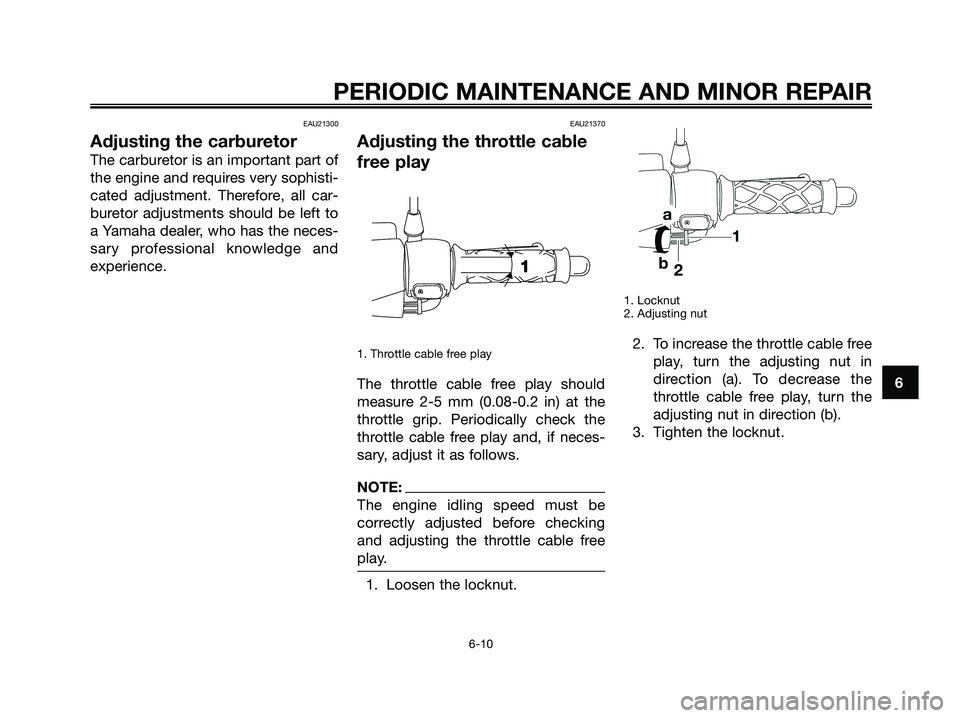
EAU21300
Adjusting the carburetor
The carburetor is an important part of
the engine and requires very sophisti-
cated adjustment. Therefore, all car-
buretor adjustments should be left to
a Yamaha dealer, who has the neces-
sary professional knowledge and
experience.
EAU21370
Adjusting the throttle cable
free play
1. Throttle cable free play
The throttle cable free play should
measure 2-5 mm (0.08-0.2 in) at the
throttle grip. Periodically check the
throttle cable free play and, if neces-
sary, adjust it as follows.
NOTE:
The engine idling speed must be
correctly adjusted before checking
and adjusting the throttle cable free
play.
1. Loosen the locknut.
1. Locknut
2. Adjusting nut
2. To increase the throttle cable free
play, turn the adjusting nut in
direction (a). To decrease the
throttle cable free play, turn the
adjusting nut in direction (b).
3. Tighten the locknut.
1
PERIODIC MAINTENANCE AND MINOR REPAIR
6-10
6
5RW-F8199-E4.QXD 19/11/07 08:01 Página 45
Page 53 of 72
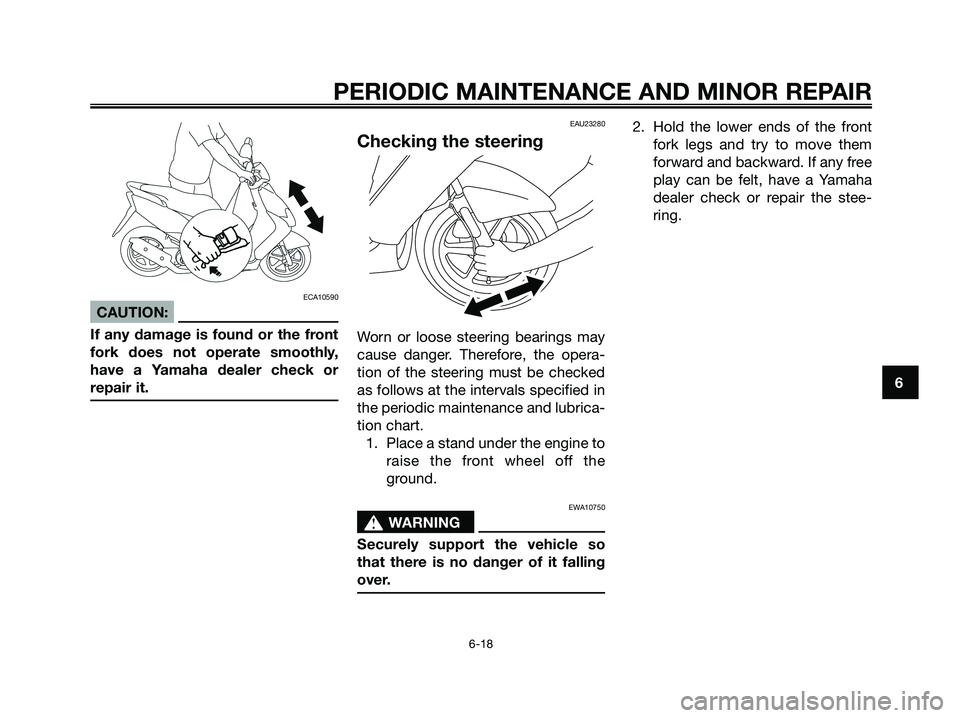
ECA10590
CAUTION:
If any damage is found or the front
fork does not operate smoothly,
have a Yamaha dealer check or
repair it.
EAU23280
Checking the steering
Worn or loose steering bearings may
cause danger. Therefore, the opera-
tion of the steering must be checked
as follows at the intervals specified in
the periodic maintenance and lubrica-
tion chart. 1. Place a stand under the engine to raise the front wheel off the
ground.
EWA10750
s s WARNING
Securely support the vehicle so
that there is no danger of it falling
over.
2. Hold the lower ends of the front fork legs and try to move them
forward and backward. If any free
play can be felt, have a Yamaha
dealer check or repair the stee-
ring.
PERIODIC MAINTENANCE AND MINOR REPAIR
6-18
6
5RW-F8199-E4.QXD 21/11/07 11:15 Página 53
Page 60 of 72
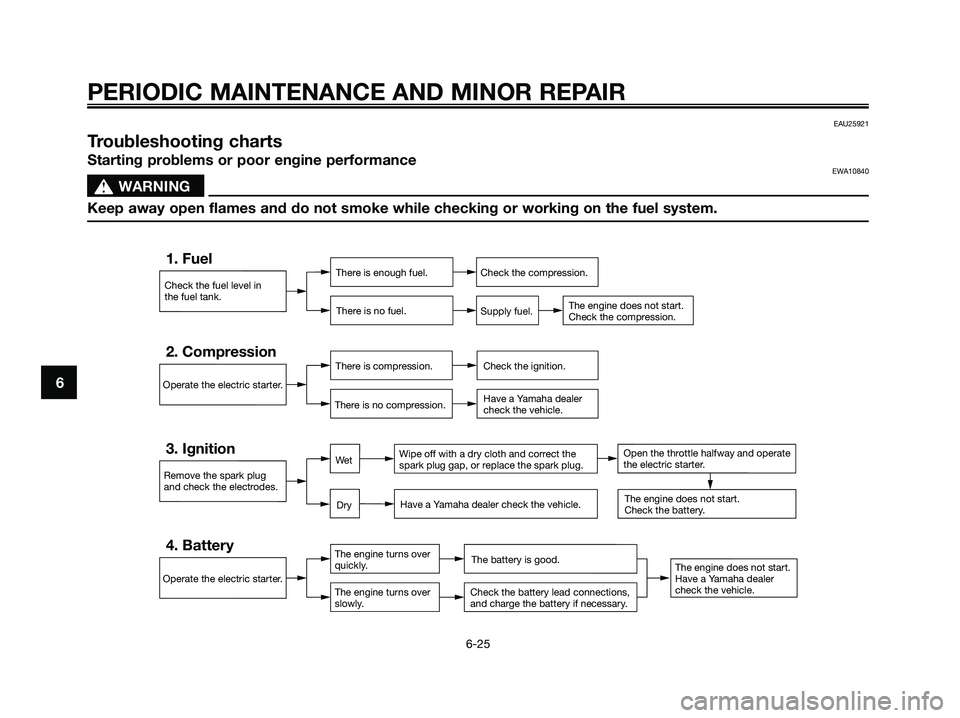
EAU25921
Troubleshooting charts
Starting problems or poor engine performanceEWA10840
s s
WARNING
Keep away open flames and do not smoke while checking or working on the fuel system.
PERIODIC MAINTENANCE AND MINOR REPAIR
6-25
6
Check the fuel level in
the fuel tank.
1. FuelThere is enough fuel.
There is no fuel.Check the compression.
Supply fuel.
The engine does not start.
Check the compression.
Operate the electric starter.
2. CompressionThere is compression.
There is no compression.Check the ignition.
Have a Yamaha dealer
check the vehicle.
Remove the spark plug
and check the electrodes.
3. IgnitionWipe off with a dry cloth and correct the
spark plug gap, or replace the spark plug.
Have a Yamaha dealer check the vehicle.
The engine does not start.
Have a Yamaha dealer
check the vehicle.
The engine does not start.
Check the battery.
Operate the electric starter.
4. BatteryThe engine turns over
quickly.
The engine turns over
slowly.The battery is good.
Check the battery lead connections,
and charge the battery if necessary.
Dry
We tOpen the throttle halfway and operate
the electric starter.
5RW-F8199-E4.QXD 19/11/07 08:01 Página 60
Page 61 of 72
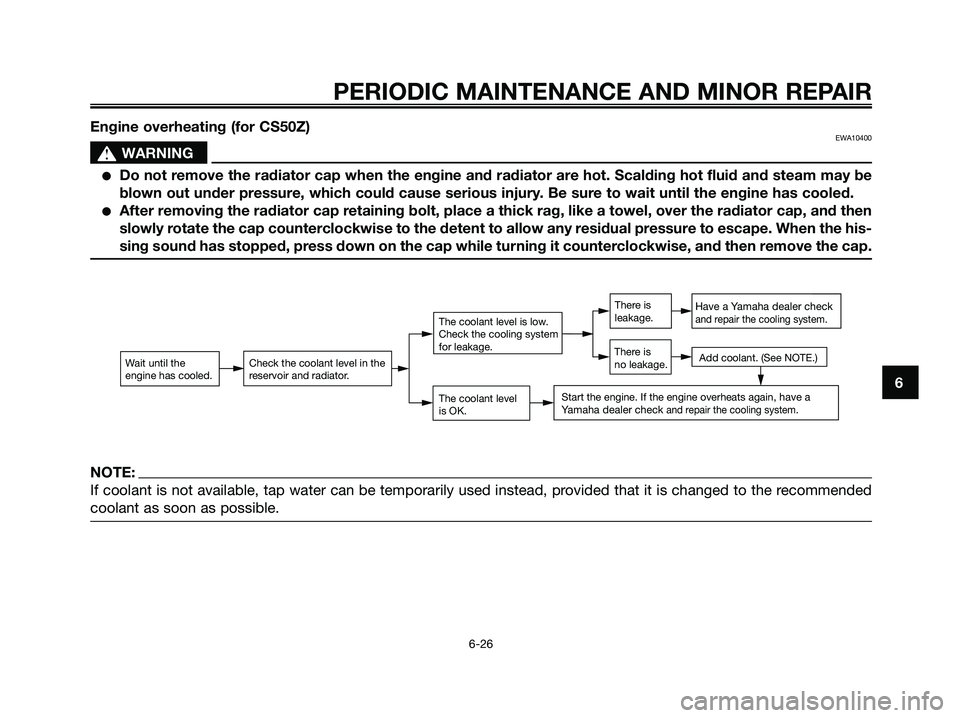
Engine overheating (for CS50Z)EWA10400
s s
WARNING
●Do not remove the radiator cap when the engine and radiator are hot. Scalding hot fluid and steam may be
blown out under pressure, which could cause serious injury. Be sure to wait until the engine has cooled.
●After removing the radiator cap retaining bolt, place a thick rag, like a towel, over the radiator cap, and then
slowly rotate the cap counterclockwise to the detent to allow any residual pressure to escape. When the his-
sing sound has stopped, press down on the cap while turning it counterclockwise, and then remove the cap.
PERIODIC MAINTENANCE AND MINOR REPAIR
6-26
6
Wait until the
engine has cooled.Check the coolant level in the
reservoir and radiator.
The coolant level
is OK.
The coolant level is low.
Check the cooling system
for leakage.
Have a Yamaha dealer checkand repair the cooling system.
Add coolant. (See NOTE.)
Start the engine. If the engine overheats again, have a
Yamaha dealer check and repair the cooling system.
There is
leakage.
There is
no leakage.
NOTE:
If coolant is not available, tap water can be temporarily used instead, provided that it is changed to the recommended
coolant as soon as possible.
5RW-F8199-E4.QXD 19/11/07 08:01 Página 61
Page 65 of 72
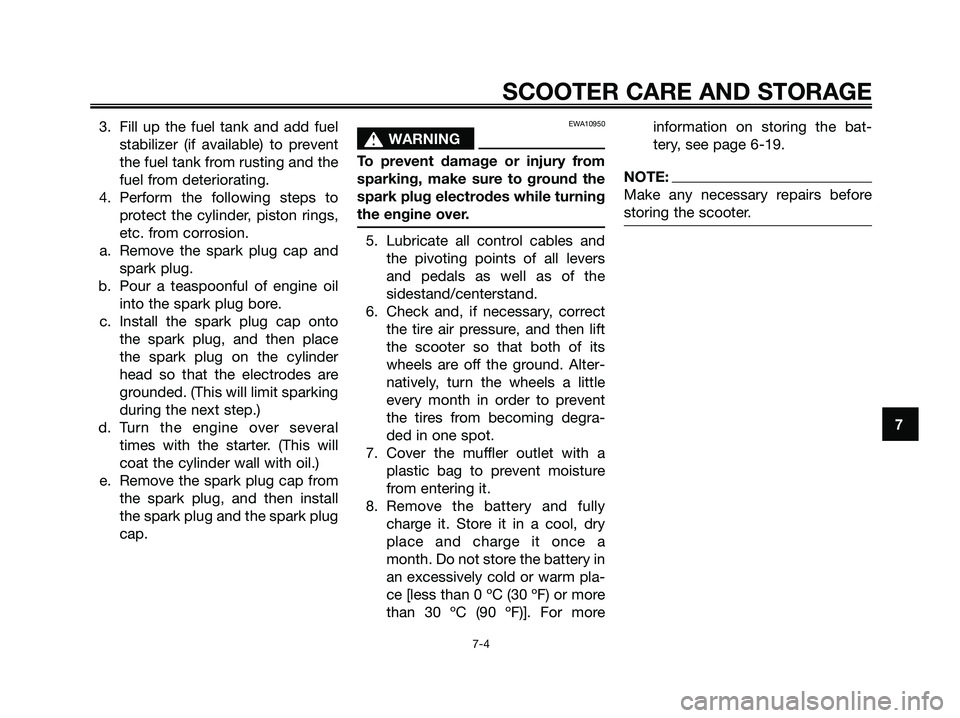
3. Fill up the fuel tank and add fuel
stabilizer (if available) to prevent
the fuel tank from rusting and the
fuel from deteriorating.
4. Perform the following steps to
protect the cylinder, piston rings,
etc. from corrosion.
a. Remove the spark plug cap and
spark plug.
b. Pour a teaspoonful of engine oil
into the spark plug bore.
c. Install the spark plug cap onto
the spark plug, and then place
the spark plug on the cylinder
head so that the electrodes are
grounded. (This will limit sparking
during the next step.)
d. Turn the engine over several
times with the starter. (This will
coat the cylinder wall with oil.)
e. Remove the spark plug cap from
the spark plug, and then install
the spark plug and the spark plug
cap.EWA10950
s s
WARNING
To prevent damage or injury from
sparking, make sure to ground the
spark plug electrodes while turning
the engine over.
5. Lubricate all control cables and
the pivoting points of all levers
and pedals as well as of the
sidestand/centerstand.
6. Check and, if necessary, correct
the tire air pressure, and then lift
the scooter so that both of its
wheels are off the ground. Alter-
natively, turn the wheels a little
every month in order to prevent
the tires from becoming degra-
ded in one spot.
7. Cover the muffler outlet with a
plastic bag to prevent moisture
from entering it.
8. Remove the battery and fully
charge it. Store it in a cool, dry
place and charge it once a
month. Do not store the battery in
an excessively cold or warm pla-
ce [less than 0 ºC (30 ºF) or more
than 30 ºC (90 ºF)]. For moreinformation on storing the bat-
tery, see page 6-19.
NOTE:
Make any necessary repairs before
storing the scooter.
SCOOTER CARE AND STORAGE
7-4
7
5RW-F8199-E4.QXD 19/11/07 08:01 Página 65
Page 71 of 72

2-stroke engine oil tank .............................3-9
AAcceleration and deceleration ...................5-2
Air filter element .........................................6-9
Auxiliary light bulb, replacing ...................6-23
BBattery......................................................6-19
Brake fluid level, checking .......................6-15
Brake fluid, changing ...............................6-16
Brake lever, front ........................................3-6
Brake lever, rear .........................................3-7
Brake levers, lubricating ..........................6-16
Brake pads and shoes, checking ............6-14
Braking .......................................................5-3
C
Carburetor,adjusting.................................6-10
Care............................................................7-1
Catalytic converter .....................................3-8
Centerstand,Checking and lubricating ....6-17
Coolant.......................................................6-8
Coolant temperature warning light ............3-3
Cowling and panel, removing
and installing............................................6-5
DDimmer switch ...........................................3-6
EEngine break-in ..........................................5-4
Engine oil ...................................................3-9
FFinal transmission oil .................................6-7
Front brake lever free play, checking.......6-13
Front fork, checking .................................6-17
Fuel ............................................................3-8
Fuel and 2-stroke engine oil tank caps .....3-7Fuel consumption, tips for reducing ..........5-3
Fuse, replacing.........................................6-20
HHandlebar switches ...................................3-6
Headlight and front turn signal light
bulb, replacing .......................................6-21
High beam indicator light...........................3-2
Horn switch ................................................3-6
IIdentification numbers ...............................9-1
Indicator and warning lights ......................3-2
KKey identification number ..........................9-1
Kickstarter ................................................3-10
LLuggage hook ..........................................3-12
MMain switch/steering lock ..........................3-1
Matte color, caution ...................................7-1
Model label ................................................9-2
Multi-function display ................................3-4
OOil level warning light .................................3-2
PParking .......................................................5-4
Part locations .............................................2-1
Periodic maintenance and lubrication
chart .........................................................6-2
Pre-operation check list .............................4-2
RRear brake lever free play, adjusting .......6-13
SSafe-riding points.......................................1-4
Safety information ......................................1-1Seat ..........................................................3-10
Spark plug, checking .................................6-6
Specifications.............................................8-1
Speedometer .............................................3-3
Start switch ................................................3-6
Starting a cold engine ................................5-1
Starting off .................................................5-2
Steering, checking ...................................6-18
Storage.......................................................7-3
Storage compartment ..............................3-11
TTail/brake light bulb or rear turn signal
light bulb, replacing ...............................6-22
Throttle cable free play, adjusting ............6-10
Throttle grip and cable, checking and
lubricating ..............................................6-16
Tires .........................................................6-11
Troubleshooting .......................................6-24
Troubleshooting charts ............................6-25
Turn signal indicator lights .........................3-2
Turn signal switch ......................................3-6
VVehicle identification number .....................9-1
WWheel bearings, checking........................6-19
Wheels .....................................................6-12
1
INDEX
5RW-F8199-E4.QXD 19/11/07 08:01 Página 71